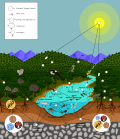Lotka–Volterra equations, also known as the Lotka–Volterra predator–prey model, are a pair of first-order nonlinear differential equations, frequently used...
34 KB (4,490 words) - 16:18, 24 April 2025
Predation (redirect from Predator and prey)
biological interaction in which one organism, the predator, kills and eats another organism, its prey. It is one of a family of common feeding behaviours...
109 KB (11,599 words) - 08:42, 20 March 2025
of the environment. The classic predator–prey equations are a pair of first order, non-linear, differential equations used to describe the dynamics of...
34 KB (4,251 words) - 16:41, 26 April 2024
cyclically around a fixed point, such as the one delineated by the predator-prey equations, would be described as persistent and resilient, but not as constant...
22 KB (2,737 words) - 05:51, 24 October 2024
Predator–prey reversal is a biological interaction where an organism that is typically prey in the predation interaction instead acts as the predator...
18 KB (2,268 words) - 20:52, 14 July 2024
(1860–1940), Italian mathematician Lotka–Volterra equations, also known as the predator–prey equations Smith–Volterra–Cantor set, a Cantor set with measure...
1 KB (174 words) - 20:48, 3 May 2024
for example, wolves prey mostly upon large herbivores (primary consumers), which eat plants (primary producers). The apex predator concept is applied in...
34 KB (3,273 words) - 20:56, 9 April 2025
predator-prey interactions and population dynamics. The model was an improvement over earlier predator-prey models, notably the Lotka–Volterra equations, by...
5 KB (586 words) - 11:35, 16 April 2025
Arditi–Ginzburg equations describe ratio-dependent predator–prey dynamics. Where N is the population of a prey species and P that of a predator, the population...
5 KB (605 words) - 22:51, 20 April 2025
predicted by the Lotka-Volterra equation, with the peaks in prey abundance shifted slightly to the left of the peaks of the predator densities. Huffaker's experiments...
14 KB (1,741 words) - 04:19, 22 August 2024
which prey densities are artificially manipulated, but is rare in nature. Carnivore Ecosystem model Herbivore Lotka–Volterra equations Predator satiation...
9 KB (1,258 words) - 11:20, 19 February 2025
formulation. The Lotka–Volterra predator-prey equations are another famous example, as well as the alternative Arditi–Ginzburg equations. Simplified population...
29 KB (3,255 words) - 00:54, 12 February 2025
became known as the Malthusian growth model. The Lotka–Volterra predator-prey equations are another famous example. Population dynamics overlap with another...
42 KB (4,341 words) - 20:51, 25 April 2025
Shoaling and schooling (redirect from Predator avoidance in schooling fish)
become circular. Forage fish are small fish which are preyed on by larger predators for food. Predators include other larger fish, seabirds and marine mammals...
105 KB (12,181 words) - 21:54, 11 March 2025
Continuous simulation (section The predator-prey model)
Lotka-Volterra equations for modeling a predator-prey eco-system) or in a more realistic manner by a discrete event simulation model (in a predator-prey eco-system...
12 KB (1,489 words) - 21:37, 23 October 2023
generalized Lotka–Volterra equations are a set of equations which are more general than either the competitive or predator–prey examples of Lotka–Volterra...
12 KB (1,821 words) - 15:07, 27 August 2024
Canada lynx (category Apex predators)
It is a specialist predator and depends heavily on the snowshoe hare (Lepus americanus) for food. This leads to a prey-predator cycle, as the Canada...
70 KB (7,990 words) - 21:33, 8 February 2025
set of first-order, nonlinear, differential equations, which are frequently used to describe predator–prey interactions, can be modified to account for...
8 KB (1,168 words) - 20:44, 4 January 2025
differential equations within biology is Lotka-Volterra equations are prey-predator equations A governing equation may also be a state equation, an equation describing...
8 KB (897 words) - 11:44, 10 April 2025
Keystone species (redirect from Keystone predator)
is a predator that prevents a particular herbivorous species from eliminating dominant plant species. If prey numbers are low, keystone predators can be...
28 KB (3,148 words) - 20:59, 10 March 2025
For this reason, functional differential equations are more applicable than ordinary differential equations (ODE), in which future behavior only implicitly...
14 KB (2,185 words) - 03:34, 2 February 2024
Herbivore (redirect from Plant predator)
equation models the efficiency at which predators consume prey. The model predicts that as the number of prey increases, the amount of time predators...
57 KB (6,490 words) - 02:13, 12 March 2025
formulation. The Lotka–Volterra predator-prey equations are another famous example, as well as the alternative Arditi–Ginzburg equations. When describing growth...
31 KB (3,557 words) - 03:55, 13 October 2024
Theoretical ecology (section Predator–prey interaction)
populations of both predator and the prey. In 1925, the American mathematician Alfred J. Lotka developed simple equations for predator–prey interactions in...
62 KB (7,505 words) - 09:01, 2 March 2025
between modelled and real predator–prey interactions. Rosenzweig used ordinary differential equation models to describe changes in prey populations. Enrichment...
10 KB (1,524 words) - 20:34, 6 February 2024
Prey switching is frequency-dependent predation, where the predator preferentially consumes the most common type of prey. The phenomenon has also been...
12 KB (1,508 words) - 13:36, 14 February 2025
introduced in the differential equations of the Kolmogorov predator–prey model. It generalizes the linear case of predator–prey interaction firstly described...
4 KB (574 words) - 16:39, 21 March 2025
Intraguild predation (redirect from Intraguild predator)
other, or symmetrical, in which both species prey upon each other. Because the dominant intraguild predator gains the dual benefits of feeding and eliminating...
16 KB (1,726 words) - 02:52, 28 October 2024
many mathematical equations, including self-oscillatory systems, excitable systems and reaction–diffusion–advection systems. Equations of these types are...
28 KB (3,415 words) - 07:38, 14 October 2024
Ecology of fear (redirect from Predator-induced stress)
the animals already living in the environment. Predator-prey dynamics – Equations modelling predator–prey cyclesPages displaying short descriptions of redirect...
13 KB (1,424 words) - 04:01, 18 November 2024

















